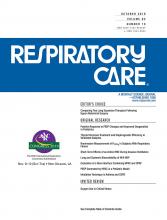Research ArticleOriginal Research
PEEP Generated by High-Flow Nasal Cannula in a Pediatric Model
Beverly D Ejiofor, Ryan W Carroll, William Bortcosh and Robert M Kacmarek
Respiratory Care October 2019, 64 (10) 1240-1249; DOI: https://doi.org/10.4187/respcare.06470
Beverly D Ejiofor
Massachusetts General Hospital, Boston, Massachusetts.
Ryan W Carroll
Massachusetts General Hospital, Boston, Massachusetts.
Harvard Medical School, Boston, Massachusetts.
William Bortcosh
Massachusetts General Hospital, Boston, Massachusetts.
Robert M Kacmarek
Massachusetts General Hospital, Boston, Massachusetts.
Harvard Medical School, Boston, Massachusetts.

References
- 1.↵
- Nishimura M
- 2.↵
- Sztrymf B,
- Messika J,
- Bertrand F,
- Hurel D,
- Leon R,
- Dreyfuss D,
- et al
- 3.↵
- Frat JP,
- Brugiere B,
- Ragot S,
- Chatellier D,
- Veinstein A,
- Goudet V,
- et al
- 4.
- Boyle M,
- Chaudhary R,
- Kent S,
- O'Hare S,
- Broster S,
- Dassios T
- 5.↵
- Papazian L,
- Corley A,
- Hess D,
- Fraser JF,
- Frat JP,
- Guitton C,
- et al
- 6.↵
- 7.↵
- Parke RL,
- Eccleston ML,
- McGuinness SP
- 8.
- Iyer NP,
- Mhanna MJ
- 9.↵
- Parke RL,
- McGuinness SP
- 10.↵
- Nielsen KR,
- Ellington LE,
- Gray AJ,
- Stanberry LI,
- Smith LS,
- DiBlasi RM
- 11.↵
- 12.↵
- Gerhardt T,
- Hehre D,
- Feller R,
- Reifenberg L,
- Bancalari E
- 13.↵
- McKiernan C,
- Chua LC,
- Visintainer PF,
- Allen H
- 14.↵
- 15.↵
- 16.↵
- Tu G,
- He H,
- Yin K,
- Ju M,
- Zheng Y,
- Zhu D,
- et al
- 17.↵
- Solomon R,
- Jurica K
- 18.
- Ganti L
- 19.↵
- 20.↵
- Stocks J
- 21.↵
- Breatnach E,
- Abbott GC,
- Fraser RG
- 22.
- Dullenkopf A,
- Kretschmar O,
- Knirsch W,
- Tomaske M,
- Hug M,
- Stutz K,
- et al
- 23.
- Griscom NT,
- Wohl ME
- 24.↵
- Itagaki T,
- Bennett DJ,
- Chenelle CT,
- Fisher DF,
- Kacmarek RM
- 25.↵
- Itagaki T,
- Chenelle CT,
- Bennett DJ,
- Fisher DF,
- Kacmarek RM
- 26.
- Likus W,
- Bajor G,
- Gruszczynska K,
- Baron J,
- Markowski J
- 27.
- Rusconi F,
- Castagneto M,
- Gagliardi L,
- Leo G,
- Pellegatta A,
- Porta N,
- et al
- 28.↵
- 29.↵
- Weiler T,
- Kamerkar A,
- Hotz J,
- Ross P,
- Newth C,
- Khemani R
- 30.↵
- Volsko TA,
- Fedor K,
- Amadei J,
- Chatburn RL
- 31.↵
- Luo JC,
- Lu MS,
- Zhao ZH,
- Jiang W,
- Xu B,
- Weng L,
- et al
- 32.↵
- Lavizzari A,
- Veneroni C,
- Colnaghi M,
- Ciuffini F,
- Zannin E,
- Fumagalli M,
- et al
- 33.↵
- Schibler A,
- Pham TM,
- Dunster KR,
- Foster K,
- Barlow A,
- Gibbons K,
- et al
- 34.↵
- Wing R,
- James C,
- Maranda LS,
- Armsby CC
- 35.↵
- Bishop MJ
- 36.
- Riese J,
- Fierce J,
- Riese A,
- Alverson BK
- 37.
- Schweiger C,
- Manica D,
- Pereira DRR,
- Carvalho PRA,
- Piva JP,
- Kuhl G,
- et al
- 38.↵
- Schweiger C,
- Marostica PJ,
- Smith MM,
- Manica D,
- Carvalho PR,
- Kuhl G
In this issue
Respiratory Care
Vol. 64, Issue 10
1 Oct 2019
PEEP Generated by High-Flow Nasal Cannula in a Pediatric Model
Beverly D Ejiofor, Ryan W Carroll, William Bortcosh, Robert M Kacmarek
Respiratory Care Oct 2019, 64 (10) 1240-1249; DOI: 10.4187/respcare.06470






